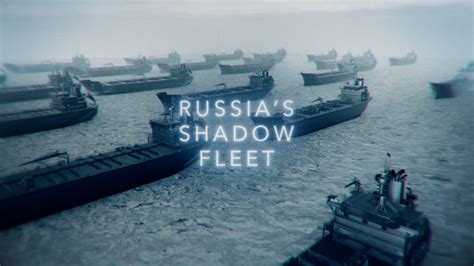
Russia is signaling a readiness for potential conflict with the West, partly to protect its assets, particularly a growing “shadow fleet” of vessels used to circumvent sanctions and maintain oil exports, according to recent statements and analyses. This fleet, amassed since the imposition of Western sanctions following the invasion of Ukraine, is increasingly vital to Moscow’s economic stability, making its protection a potential flashpoint.
Russia’s increasing reliance on its “shadow fleet” of tankers and other vessels has heightened concerns about potential confrontations in international waters. The fleet, which has been described as “massive” and involved in “illicit activities,” is used to transport oil and other commodities, circumventing Western sanctions imposed in response to Russia’s invasion of Ukraine. According to the report, this shadow fleet is a key factor in the Kremlin’s posture of readiness to defend its economic interests, even if it risks escalating tensions with the West.
Growing Reliance on Shadow Fleet
Since the imposition of sanctions, Russia has been working to reroute its energy exports to countries like China and India, which have not joined the Western sanctions regime. However, these routes often involve longer distances and more complex logistics. The shadow fleet allows Russia to bypass restrictions on insurance and other services that would normally prevent sanctioned entities from trading globally.
“Russia has been building up its shadow fleet to continue exporting oil despite Western sanctions,” explains an expert in maritime law and sanctions compliance. “This fleet operates outside the bounds of normal maritime regulations and standards, increasing the risk of accidents and environmental damage.”
The expansion of the shadow fleet has also been linked to increased activity in areas like the Baltic Sea, where concerns have been raised about potential sabotage of critical infrastructure. Some nations, including those in Scandinavia, have expressed alarm over Russia’s increased naval presence in the region.
Russia’s Readiness for Confrontation
The article suggests that Russia is prepared to defend its economic interests, including the operations of its shadow fleet, even if it means risking war with the West. The signals of readiness were highlighted in conjunction with discussions about Western military support for Ukraine, suggesting a determination to counter what Moscow perceives as aggressive actions by NATO and its allies.
This willingness to escalate tensions is rooted in Russia’s belief that the West is actively trying to undermine its economic and political stability. Moscow views the sanctions as an attempt to cripple its economy and weaken its ability to project power on the global stage. The shadow fleet, therefore, is seen as a critical tool for maintaining economic independence and resisting Western pressure.
“Russia perceives the sanctions as an act of economic warfare,” says a political analyst specializing in Russian foreign policy. “They believe that the West is trying to isolate and weaken them, and they are prepared to use all means necessary to protect their interests.”
Geopolitical Implications
The potential for conflict stemming from the shadow fleet’s operations is a significant concern for several reasons. First, the fleet operates in international waters, where any confrontation could quickly escalate into a broader conflict. Second, the fleet’s activities are often clandestine, making it difficult to assess the true extent of its operations and the risks involved. Third, the fleet’s environmental impact is a growing concern, as many of the vessels are old and poorly maintained, increasing the risk of oil spills and other disasters.
“The shadow fleet is a ticking time bomb,” warns a maritime security expert. “It poses a risk not only to international security but also to the environment. A major oil spill in the Baltic Sea, for example, could have devastating consequences.”
The situation is further complicated by the fact that many of the vessels in the shadow fleet are owned by shell companies and operated by individuals with ties to the Russian government. This makes it difficult to hold them accountable for their actions and to enforce sanctions effectively.
Economic Consequences
The shadow fleet plays a crucial role in Russia’s ability to maintain its oil exports, which are a major source of revenue for the Russian government. Despite the sanctions, Russia has been able to continue exporting significant quantities of oil to countries like China and India, helping to offset the impact of the sanctions.
However, the use of the shadow fleet comes at a cost. The fleet is more expensive to operate than traditional shipping companies, and it is also more vulnerable to disruptions and attacks. The increased risk associated with the fleet’s operations has also led to higher insurance rates, further increasing the cost of exporting oil.
“The shadow fleet is a costly and inefficient way to export oil,” says an energy economist. “It is a temporary solution that is not sustainable in the long term. Russia needs to find a way to reintegrate into the global economy if it wants to maintain its oil exports.”
Western Response
The West has been working to crack down on the shadow fleet, but it has faced significant challenges. Many of the vessels are registered in countries with lax regulatory standards, and they often operate under false flags to avoid detection.
The United States and the European Union have imposed sanctions on some of the companies and individuals involved in the shadow fleet, but these measures have had limited success. The fleet continues to operate, and Russia has been able to find ways to circumvent the sanctions.
“The West needs to take a more aggressive approach to cracking down on the shadow fleet,” says a sanctions expert. “This includes imposing stricter sanctions on the companies and individuals involved, as well as increasing surveillance of the fleet’s operations.”
Increased Military Activity
The article also notes an increase in Russian military activity in areas where the shadow fleet operates. This includes naval patrols, air patrols, and electronic warfare operations. The purpose of this increased activity is to deter Western interference with the fleet’s operations and to protect it from potential attacks.
The increased military activity has raised concerns about the potential for miscalculation and escalation. A minor incident could quickly spiral out of control, leading to a broader conflict.
“The risk of accidental conflict is very high,” warns a military analyst. “The West and Russia need to establish clear rules of engagement to avoid misunderstandings and prevent escalation.”
Conclusion
The Russia shadow fleet represents a complex challenge for the West. It is a critical tool for Russia’s economic survival, but it also poses a risk to international security and the environment. The West needs to find a way to crack down on the fleet’s operations without provoking a wider conflict. This will require a combination of diplomacy, sanctions, and increased military vigilance. The situation requires constant observation and adaptation as Russia’s strategies evolve in response to international pressure and the changing geopolitical landscape. The potential for miscalculation and escalation remains a significant concern, necessitating careful and coordinated responses from the West. The shadow fleet, therefore, is not merely an economic issue but a complex geopolitical challenge with far-reaching implications.
FAQ on Russia’s Shadow Fleet
1. What is Russia’s shadow fleet?
Russia’s shadow fleet is a collection of tankers and other vessels that Russia uses to circumvent Western sanctions and maintain oil exports. These vessels operate outside the normal bounds of maritime regulations and standards, often using shell companies and operating under false flags to avoid detection.
2. Why did Russia create a shadow fleet?
Russia created the shadow fleet in response to Western sanctions imposed after its invasion of Ukraine. These sanctions restricted Russia’s ability to export oil using traditional shipping companies and insurance services. The shadow fleet allows Russia to bypass these restrictions and continue exporting oil to countries like China and India.
3. What are the risks associated with the shadow fleet?
The shadow fleet poses several risks:
- Environmental damage: The vessels are often old and poorly maintained, increasing the risk of oil spills and other disasters.
- Security risks: The fleet operates clandestinely, making it difficult to assess the true extent of its operations and the risks involved. The absence of regulation and oversight significantly increases the risk of maritime accidents.
- Geopolitical tensions: The fleet’s operations have led to increased military activity in areas like the Baltic Sea, raising concerns about potential confrontations between Russia and the West.
- Economic risks: The fleet is more expensive to operate than traditional shipping companies and is more vulnerable to disruptions and attacks. The use of such fleets can lead to higher transaction costs, insurance premiums, and potential legal challenges for involved parties.
4. How is the West responding to the shadow fleet?
The West has been working to crack down on the shadow fleet through sanctions and increased surveillance. The United States and the European Union have imposed sanctions on some of the companies and individuals involved in the fleet. However, the effectiveness of these measures has been limited, and the fleet continues to operate.
5. What are the potential consequences of a confrontation over the shadow fleet?
A confrontation over the shadow fleet could have serious consequences:
- Escalation of tensions: Any incident involving the fleet could quickly escalate into a broader conflict between Russia and the West.
- Disruption of oil supplies: An attack on the fleet could disrupt Russia’s oil exports, leading to higher oil prices and economic instability.
- Environmental damage: A major oil spill resulting from a confrontation could have devastating consequences for the environment.
- Economic sanctions: Further escalation of tension could lead to additional, more impactful sanctions on Russia which could destabilize global markets.
Expanded Analysis and Context
The emergence of Russia’s “shadow fleet” is a direct consequence of the economic warfare initiated by Western sanctions in response to the invasion of Ukraine. These sanctions, aimed at crippling Russia’s ability to finance the war, targeted the country’s energy sector, which is the backbone of its economy. The goal was to limit Russia’s oil exports, a primary source of revenue. However, the sanctions also created an incentive for Russia to find ways to circumvent these restrictions, leading to the creation of the shadow fleet.
The Mechanics of Circumvention:
The shadow fleet employs several strategies to bypass sanctions. One of the most common is the use of ship-to-ship transfers, where oil is transferred from Russian tankers to other vessels in international waters. This obscures the origin of the oil and makes it more difficult to track. Another strategy involves using older, less well-maintained tankers that are not subject to the same level of scrutiny as newer vessels. Many of these tankers are registered in countries with lax regulations, making it easier to avoid detection. Shell companies are often used to own and operate these vessels, further obscuring their connection to Russia.
The Role of Non-Aligned Nations:
The effectiveness of the shadow fleet depends, in part, on the cooperation of non-aligned nations, particularly China and India. These countries have continued to purchase Russian oil despite the sanctions, providing a market for the oil transported by the shadow fleet. While these nations have not explicitly endorsed Russia’s actions in Ukraine, their continued economic ties with Russia have helped to mitigate the impact of the sanctions. The purchase of Russian oil at discounted rates has also benefited these nations, further incentivizing their continued cooperation.
Environmental Concerns in Detail:
The environmental risks associated with the shadow fleet are substantial. Many of the vessels in the fleet are old and poorly maintained, increasing the risk of accidents and oil spills. These vessels often lack modern safety equipment and are not subject to the same rigorous inspections as newer vessels. The lack of insurance coverage for these vessels also means that there may be limited resources available to respond to an oil spill. A major oil spill in the Baltic Sea or other sensitive marine environment could have devastating consequences for marine life and coastal communities. The environmental impact could also extend to other countries in the region, leading to international tensions.
Security Implications Expanded:
The security implications of the shadow fleet extend beyond the risk of military confrontation. The fleet’s clandestine operations also raise concerns about smuggling and other illicit activities. The lack of transparency and regulation makes it easier for criminal organizations to use the fleet to transport drugs, weapons, and other contraband. The fleet could also be used to facilitate cyberattacks or other forms of sabotage. The increased naval activity associated with the shadow fleet has also led to heightened tensions in areas like the Baltic Sea. Russia has been conducting naval exercises and patrols in the region, which some countries view as provocative. The risk of miscalculation or accidental conflict is real.
Economic Implications in Detail:
While the shadow fleet has helped Russia to maintain its oil exports, it has also come at a cost. The fleet is more expensive to operate than traditional shipping companies, and it is also more vulnerable to disruptions and attacks. The increased risk associated with the fleet’s operations has led to higher insurance rates, further increasing the cost of exporting oil. The use of the shadow fleet also undermines the credibility of the international sanctions regime. It sends a message that sanctions can be circumvented, which could embolden other countries to violate international norms. The shadow fleet also distorts the global oil market, creating an uneven playing field for companies that are complying with sanctions.
Western Response Strategies (Expanded):
The West has been struggling to find effective ways to crack down on the shadow fleet. Sanctions have had limited success, and increased surveillance has been difficult to implement. One of the challenges is that many of the vessels in the fleet are registered in countries with lax regulatory standards. This makes it difficult to hold them accountable for their actions. Another challenge is that the fleet operates clandestinely, making it difficult to track its movements. The West could consider a number of additional measures to crack down on the shadow fleet. These include:
- Imposing secondary sanctions: These sanctions would target companies and individuals that are facilitating the operations of the shadow fleet, even if they are not directly involved in the oil trade.
- Increasing diplomatic pressure: The West could put pressure on countries that are allowing the shadow fleet to operate in their waters or register its vessels.
- Strengthening maritime security: The West could increase its naval presence in areas where the shadow fleet operates to deter illegal activities.
- Sharing intelligence: The West could share intelligence with other countries to help them identify and track vessels involved in the shadow fleet.
- Enforcing existing sanctions more rigorously: This would involve increasing inspections of vessels suspected of violating sanctions and imposing penalties on those found to be in violation.
Geopolitical Ramifications (Deeper Dive):
The shadow fleet has broader geopolitical ramifications beyond the immediate issue of sanctions evasion. It represents a challenge to the international rules-based order and a test of the West’s ability to enforce its foreign policy objectives. The fleet is just one example of Russia’s efforts to undermine Western influence and assert its own power on the global stage. The situation has also led to increased tensions between Russia and some of its neighbors, particularly in the Baltic Sea region. Countries like Finland and Sweden, which have historically been neutral, have joined NATO in response to Russia’s aggression, further escalating tensions. The shadow fleet has become a symbol of the broader geopolitical struggle between Russia and the West.
Long-Term Implications:
The long-term implications of the shadow fleet are uncertain. It is possible that the fleet will continue to operate for years to come, allowing Russia to maintain its oil exports despite the sanctions. However, it is also possible that the West will eventually find more effective ways to crack down on the fleet, either through sanctions or other measures. The future of the shadow fleet will depend on a number of factors, including the duration of the sanctions, the effectiveness of Western enforcement efforts, and the willingness of non-aligned nations to continue purchasing Russian oil. The shadow fleet will likely remain a source of tension and instability for the foreseeable future.
The evolution and persistence of Russia’s shadow fleet underscores the complexities and challenges associated with enforcing international sanctions. It highlights the need for adaptable strategies, robust international cooperation, and a thorough understanding of the geopolitical and economic factors driving such behaviors. As global dynamics continue to shift, the shadow fleet serves as a stark reminder of the ongoing efforts by nations to navigate and sometimes circumvent established norms and regulations in pursuit of their strategic interests.









